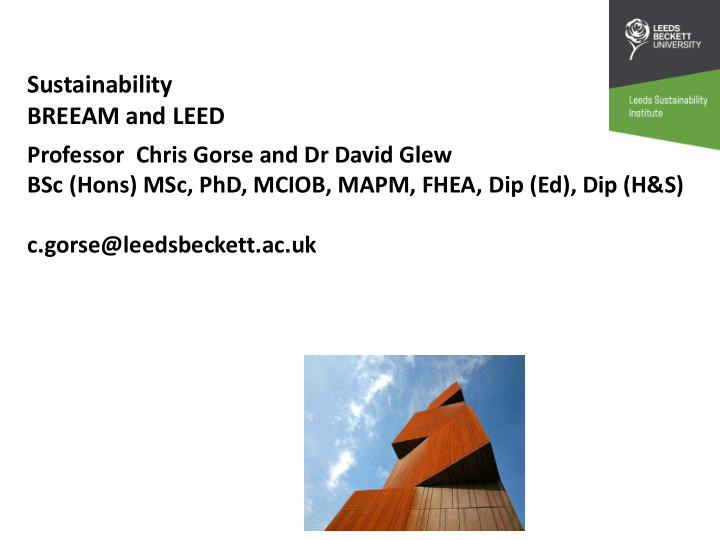



Sustainability BREEAM and LEED Professor Chris Gorse and Dr David Glew BSc (Hons) MSc, PhD, MCIOB, MAPM, FHEA, Dip (Ed), Dip (H&S) c.gorse@leedsbeckett.ac.uk
Know where you are going Engineering in Yorkshire John Harrison (Foulby, Wakefield), solved the longitude problem, Calculating longitude while at sea. Carpenter and repaired clocks in his spare time (1714 Longitude Act) The John Harrison clock is on display in the Leeds museum
UK’s s posi osition on on su sustainability ty: be before i it realis ised ‘ ‘zero carbon’ w wasn’t g going t to be be achi hieved In 2007, Building a Greener Future document: The Government’s policy statement confirmed all new homes would be zero carbon by 2016 . Achieved through a staged improvement to Building Regulations 2010, 2013 and 2016. A zero target for non-domestic was set for 2019.
Progr gres ess 2013 a and nd adj djus ustmen ent 2013 Reconfirming its zero carbon homes policy in the Budget, noting that the Regulations (2013) fell short of their tarket, the government claimed it was still on track. 2014, Queen’s Speech, reiterated zero carbon homes 2016 policy and the intention to use allowable solutions (off-setting carbon scheme). The announcement also introduced an exemption for small sites (10 or fewer units). 2015 February, provided enabling powers for Allowable Solutions under the Infrastructure Act.
Back trac ack! Plan anning Reforms As part of the Productivity Review ‘Fixing the Foundations’ On Friday 10 July 2015, the Government announced that: it “ does not intend to proceed with the zero carbon Allowable Solutions carbon offsetting scheme, or the proposed 2016 increase in on-site energy efficiency standards ”. Ares, E (2016) Zero Carbon Homes, Briefing Paper, No 6678, 27 th April 2016, http://researchbriefings.files.parliament.uk/documents/SN06678/SN06678.pdf
The he import rtance o ce of pr produ duct ctivity “Higher productivity increases household income. Productivity is the single most important determinant of average living standards and is tightly linked to the difference in wages across countries”
Where are we now? • Local authority powers devolved, Deregulation Act 2015 removed requirement to build above Regulatory standards for new homes. • Consultation doc indicates that LA can continue to set policies above Building Regs up to Code level 4. Unclear for non-domestic if authorities can continue to require higher than regulations for planning purposes. • European Energy Performance Directive. Nearly zero has always been subject to a cost effectiveness test. • Wales and Scotland may take a different approach. • London Major – 18 Nov 2016 Continues to build net zero with offsite allowable solutions for major developments. • Housing and Planning Bill (2015-16): Carbon compliance standard • Commons committed to a “Duty to review minimum energy performance requirements”
BREEAM Assessments
BREEAM and LEED • BREEAM – Building Research Establishment’s (BRE) Environmental Assessment Method (new and refurbished projects) • Not regulatory • “BREEAM is the world's leading sustainability assessment method for masterplanning projects, infrastructure and buildings. It addresses a number of lifecycle stages such as New Construction, Refurbishment and In- Use. Globally there are more than 556,000 BREEAM certified developments, and almost 2,259,300 buildings registered for assessment since it was first launched in 1990” • LEED, or Leadership in Energy and Environmental Design, • “is changing the way we think about how buildings and communities are planned, constructed, maintained and operated. Leaders around the world have made LEED the most widely used third-party verification for green buildings, with around 1.85 million square feet being certified daily”
BREEAM and LEED Categories
LEED LEED or or BREE REEAM • ‘BREEAM is the principal measure of sustainability [for non-domestic] of sustainability in building in the UK and is embedded in regulations, but everywhere else in the world LEED wins outright” Nigel Ostime (Mark 2013) • Whiles BREEAM, to our knowledge is not embedded within UK Regulation, it is often used as part of planning agreements. • Mark, L. (2013) LEED outstrips BREEAM across the globe – including Europe. The Architects’ Journal 28 February, 2013 https://www.architectsjournal.co.uk/news/leed-outstrips-breeam- across-the-globe-including-europe/8643464.article
LEED LEED v v’s BREE REEAM https://www.architectsjournal.co.uk/news/leed-outstrips-breeam-across-the- globe-including-europe/8643464.article
Gl Global al L LEAD - LEED LEED • Timothy Makower, principal, Makower Architects: ‘This is a question about global branding, interchangeability and the perception of ‘value ’. The reason that LEED is taken outside the UK is, I believe, not so much because people compare the two and make a choice but because they ‘default’ to the one with the greater global reach - ie LEED. • ‘That said, BREEAM could have done a better job at branding itself as ‘the’ standard. But these things take vast investments. (Mark 2013)
UK C Climate trees, plants, animals have already changed warmer dryer summers, wetter winters 80% less snow! (than today) Met Office regional climate
Apparent improving in housing stock DECC, Energy Performance of Buildings Certificates: Statistics Release Q1 2008 to Q3 2016
Domestic energy use trends DECC, Summary of analysis using the National Energy Efficiency Data-Framework (NEED), (2016)
Post occupancy assessments from 2008 The Digest of BREEAM Assessment Statistics Volume 1 (2014)
BREEAM assessment stage BREEAM UK, New Construction, Non Domestic Buildings, Technical Manual (2014)
Real-life energy use David Johnston and Mark Siddall, The Building Fabric Thermal Performance of Passivhaus Dwellings, Does It Do What It Says on the Tin?, Sustainability, (2016)
With g grea eat po power er comes es ev even en grea eater r resp esponsi sibility! Professor Christopher Gorse and Dr David Glew
Recommend
More recommend